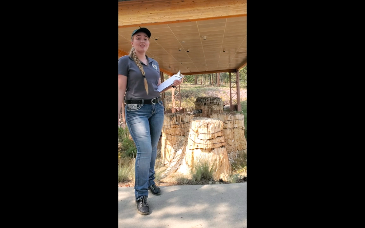Last updated: August 14, 2022
Lesson Plan
Inventory + Monitoring Evaluations

- Grade Level:
- Upper Elementary: Third Grade through Fifth Grade
- Subject:
- Science
- Lesson Duration:
- 60 Minutes
- Thinking Skills:
- Understanding: Understand the main idea of material heard, viewed, or read. Interpret or summarize the ideas in own words. Evaluating: Make informed judgements about the value of ideas or materials. Use standards and criteria to support opinions and views.
Essential Question
How can we protect known fossil sites so that they can continue to help science?
Objective
Students will study an outcrop that has been excavated along with 2 petrified stumps and make their best judgements on the amount of erosion that has occurred, what is being done to prevent erosion, how many fossils they see, how many fossils they think have been damaged/stolen/lost, how accessible the site it, and what is being done to protect the sites. They will be evaluating the sites based on a number system.
Background
Paleontologists visit different sites around the National Monument and monitor any changes to the sites they visit. Our version has been modified for our students understanding and using simpler numbers to evaluate the sites. Make sure to point out and explain the process the paleontologists use i.e.: photomarker, current technology, the precision each photo must have, etc.
Preparation
You will need:
-
I+M Excavation Site video
-
I+M Evaluation sheet
-
A pencil or pen
Materials
Lesson Hook/Preview
One of the difficulties paleontologists face is the preservation of their excavation sites so that they can continue to go back to find more fossils. Paleontologists regularly visit multiple sites at Florissant Fossil Beds National Monument and monitor changes to the sites. You are going to evaluate three sites from the National Monument and write down your evaluation on an I + M sheet.One of the difficulties paleontologists face is the preservation of their excavation sites so that they can continue to go back to find more fossils. Paleontologists regularly visit multiple sites at Florissant Fossil Beds National Monument and monitor changes to the sites. You are going to evaluate three sites from the National Monument and write down your evaluation on an I + M sheet.
Procedure
#1: Print out an I+M Evaluation sheet for each student. Go over what each factor means and how they will be rated. The I+M evaluation sheet is similar to what paleontologists use in the field to rate several factors of the preservation of their sites.For each site, you will be rating six factors based on your own observations. Erosion is how much sediment you estimate has been moved. Erosion prevention is what has been done to prevent further erosion. Fossil abundance is how many fossils you can see at the site. Actual loss is how many fossils you think have been stolen, damaged, or lost to other factors such as erosion. Site access is how easy it is for people to get to the site. Access prevention is what has been done to protect the site and keep people from getting to the site when they shouldn’t be there. You will rate each factor from 1 to 3.
#2: Open the I+M Excavation Sites video and have the student(s) watch it. Pause or allow the student(s) to pause the video as needed to take time to look at the sites and make observations. Have the student(s) write down which site they are evaluating on the I+M evaluation sheet and rate each factor.
Vocabulary
-
Erosion: noun; the action or process of eroding or wearing away by or as if by the action of water, wind, or glacial ice
-
Erosion Prevention: noun; the act or practice of keeping erosion from happening
-
Fossil Abundance: noun; the quantity of fossils found at a site
-
Actual Loss: noun; the amount of loss of material or fossils from a site
-
Site Access: noun; the state of how easily a site can be reached by people
-
Access Prevention: noun; the measures that are taken to prevent or keep people from reaching a site
Assessment Materials
ReflectionLook at your filled in evaluation sheet. How do the sites you evaluated differ from each other? How are the sites similar? What do you think could be done to help preserve and protect these sites?
Rubric/Answer Key
Some sites might have more fossils than others or different types of fossils. Some might be more accessible or have been worked at more than others. Some possible ways to help protect these sites include monitoring them and educating visitors to look but not touch.
Additional Resources
Check out our I+M Evaluations activity webpage for step by step instructions with pictures!
